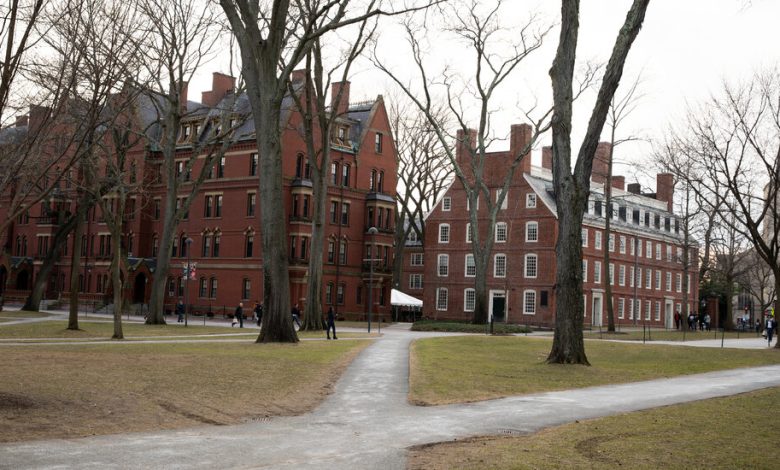How Much Influence Should Universities Give Their Donors?

Some of the most powerful people in business have taken aim at universities over their responses to the Hamas terrorist attack on Israel and to accusations of antisemitism.
Marc Rowan, the chief executive of Apollo Global Management and a major donor to the University of Pennsylvania, has called for the resignation of the school’s president and its chairman. Former Ambassador Jon Huntsman halted giving to the school, and Ron Lauder, the Estée Lauder cosmetics heir, said he was “re-examining” his financial support.
Donors accuse Penn of applying its free-speech values inconsistently. Clifford Asness, the chief investment officer at AQR Capital Management, wrote in a letter to the university’s Wharton School this week that he had “long been dismayed at the drift away from true freedom of thought” and would not consider donating until “meaningful change was evident.”
At Harvard, the Israeli billionaire Idan Ofer and the Victoria’s Secret founder Leslie Wexner have cut ties with the school after student groups signed a petition blaming Israel for the Hamas attack.
Big donors to universities have long expected special treatment, like preference for their children’s applications. But these demands aim to shape the universities’ core values and unseat top leadership.
Universities helped create the expectation that donations come with influence. Like most nonprofits, U.S. universities foster relationships with some donors by offering them seats on the board of the trustees. The job comes with real power: Trustees vote on decisions like tenure and the selection of the university president. For smaller donors, schools sometimes offer membership to alumni councils or advisory circles, which don’t come with fiduciary responsibilities but provide a platform for influencing decisions.
The question is how far the influence of individual donors should extend. “The job of a college or university president is very hard because, on the one hand, he or she has to keep the trustees happy — because they are big givers and because they can fire the president,” Edward Rock, a professor of law at New York University who specializes in corporate governance said. “At the same time, he or she has to make sure that the university’s academic mission is not compromised by external forces, whether they be political forces or economic forces.”
This potential conflict is not new. In 1995, Yale returned a $20 million gift from a billionaire alumnus after he demanded selection of professors in the Western civilization program he funded. Leaders of Penn’s faculty senate argued in a letter this week that donors pushing for the university’s president and chairman to resign over a Palestinian literature festival that was held on campus, which the donors say presented antisemitic ideas, had similarly gone too far.
“Academic freedom is at the heart of our educational and research missions,” they wrote. “And we demand that it remain free from internal or external pressure or coercion.”
Even the best-funded universities work to keep big donors. The endowments of elite universities are as large as some of today’s best-known funds. Penn has an endowment of $21 billion. Harvard has $50 billion. Even with these big coffers, the apparent exodus of money is meaningful, experts told DealBook.
The criticism from well-known businesspeople could influence smaller and future donors. And often, donors’ contributions are allocated toward specific programs, which means there’s less cash for universities to freely spend than headline sums might imply.
“No matter what, it’s going to be a crunch to their operating fund,” said Larissa Reece, a consultant at Ashley Rountree and Associates who advises schools on fund-raising. “Even Harvard, with their resources and endowments, still requires an annual fund to keep the basics of some things at the university running.”
Not all of Penn’s big donors are willing to withdraw support over the current debate. Blackstone Group’s C.E.O., Jon Gray, who, alongside his wife, donated $55 million to Penn for cancer research and $10 million for supporting low-income children, said this week that he would continue to support the university despite Rowan’s campaign.
“Those are long-term missions for us,” Gray told Bloomberg. “The decision about her future,” he added, referring to the university’s president, “lies with the board of trustees at Penn.” — Lauren Hirsch
IN CASE YOU MISSED IT
Representative Jim Jordan is out as House speaker nominee. After the far-right Ohio lawmaker failed for a third time to win election as speaker on Friday, Republicans voted to drop him as the nominee. There is no consensus among Republicans about an alternative candidate, as the House remains paralyzed.
Netflix shares pop on strong subscriber growth. The streaming giant on Wednesday reported better-than-expected earnings, despite Hollywood strikes that have brought film and television production to a near standstill. Netflix added roughly nine million new subscribers last quarter, even as it stepped up its crackdown on password sharing. Investors also cheered news that it will raise prices on some subscription plans.
Jay Powell leaves the door open for more interest-rate increases. The Federal Reserve chair signaled on Thursday that the central bank was prepared to leave rates unchanged at its meeting in November, but that it could raise them later if data showed the economy was running too hot. Powell said policymakers were also closely monitoring geopolitical tensions. Turmoil in the Middle East has sent oil prices higher in recent days, which could push up inflation and weigh on growth.
The U.S. deficit doubled in the past year. Treasury reported a deficit of $1.7 trillion for the 2023 fiscal year, which ended on Sept. 30, but the total actually hit $2 trillion once President Biden’s student-loan plan and its demise are taken into account. Republicans have blamed the shortfall on excessive federal spending; Democrats point to the Trump tax cuts. The big culprit appears to be lower tax revenues unrelated to those cuts.
The right way to fail
Amy Edmondson, a management professor at Harvard Business School, is an expert on what makes teams and organizations successful. Her latest book, “Right Kind of Wrong,” argues that a crucial piece of that puzzle is a willingness to fail.
DealBook spoke with Edmondson about why failure can be useful, if done right. The interview has been condensed and edited.
You call one of your concepts “intelligent failure.” How does that differ from a mistake?
To have a mistake, there has to be a recipe to use and it wasn’t used. An intelligent failure is one that occurs in new territory in pursuit of a goal, where you had good reason to believe what you tried might work.
You’ve written that a healthy relationship with failure allows people to “play to win” instead of “playing not to lose.” What do you mean by that?
When we play to not lose, we don’t take risks. We go for good enough. That’s more certain compared to the stretch goals, and so it’s much safer and more natural to do. But no innovation ever came that way.
How do business leaders avoid creating an organization that encourages people to play not to lose?
Organizations penalize people for things that go wrong rather than rewarding the well-intended, thoughtful, smart efforts that those failures represented. I’ve had countless managers at all levels tell me, “I was trying something new, I was innovating, our team learned a lot from it,” only to later on in their annual performance review hear something along the lines of “Well, we see you made this mistake here, and we hold that against you.”
How does your earlier work about “psychological safety” factor into how managers can create an environment where it’s OK to fail?
Psychological safety is an environment where people believe that interpersonal risks can be taken, which is speaking up truthfully about what’s really happening. And they believe they won’t be penalized or punished or humiliated for that kind of candor. And so that’s important both for innovation and to encourage people to take risks.
It’s also crucial for preventing preventable failures. I’m all for preventing as many failures that are caused by error in known territory as humanly possible. And that can only happen when people are willing to speak up with concerns or questions about something and ask for help when they need it.
Is there an example that illustrates the wrong kind of failure?
Sam Bankman-Fried provides one of the most visible business failure stories in the news today. The massive failure of his company does not qualify as an intelligent one. Yes, it was a new territory; yes, he had done his homework and was deeply knowledgeable about technology and markets; and, yes, it was driven by a goal. But the size of the failure is far from helpful in providing valuable new knowledge about Bitcoin. And, rather than sincere experiments and genuine innovation, lying and deception were built into the business model for a long time.
Thanks for reading! We’ll see you Monday.
We’d like your feedback. Please email thoughts and suggestions to [email protected].



